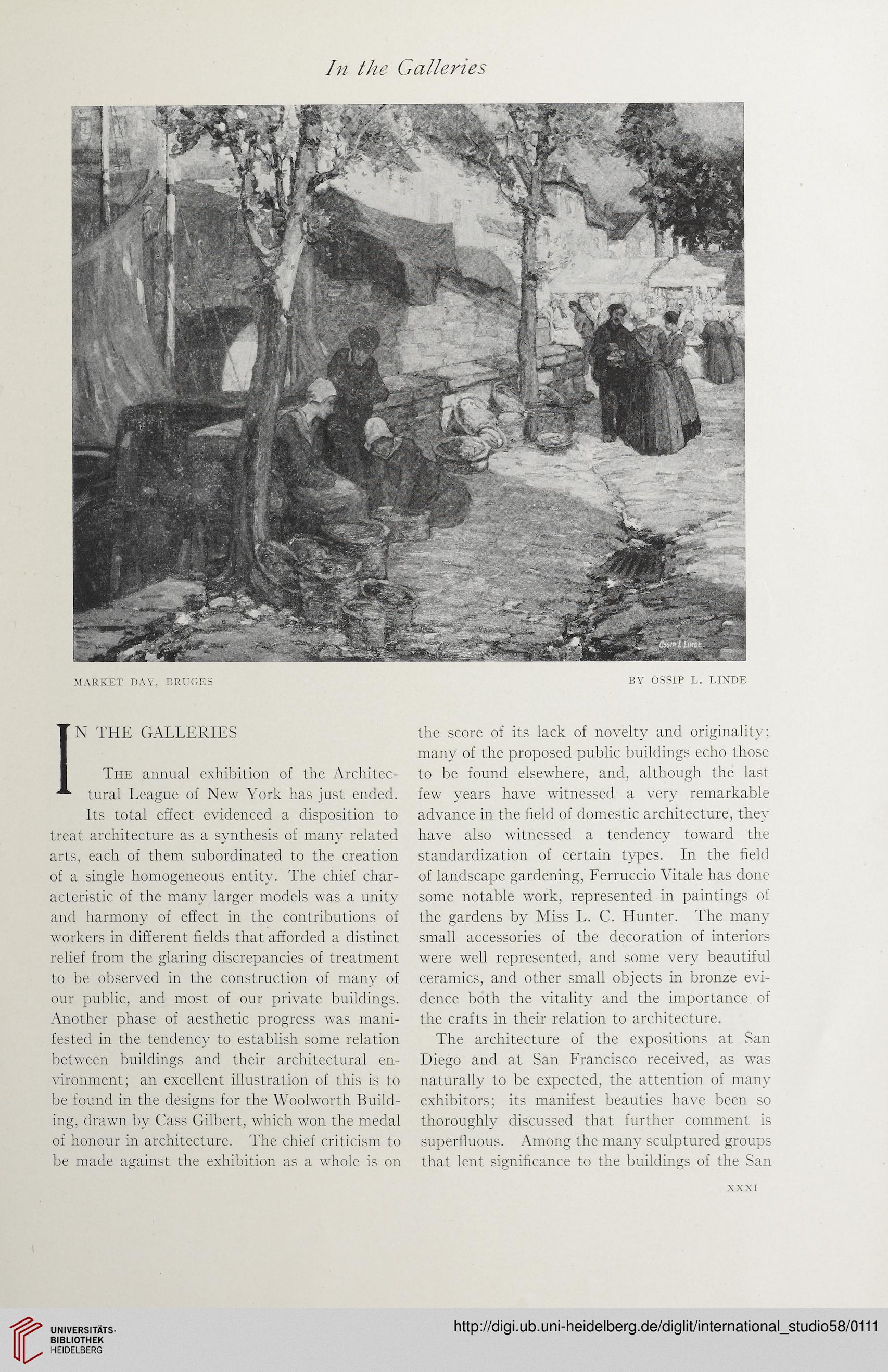In the Galleries
MARKET DAY, BRUGES
BY OSSIP L. LINDE
IN THE GALLERIES
The annual exhibition of the Architec-
tural League of New York has just ended.
Its total effect evidenced a disposition to
treat architecture as a synthesis of many related
arts, each of them subordinated to the creation
of a single homogeneous entity. The chief char-
acteristic of the many larger models was a unity
and harmony of effect in the contributions of
workers in different fields that afforded a distinct
relief from the glaring discrepancies of treatment
to be observed in the construction of many of
our public, and most of our private buildings.
Another phase of aesthetic progress was mani-
fested in the tendency to establish some relation
between buildings and their architectural en-
vironment; an excellent illustration of this is to
be found in the designs for the Woolworth Build-
ing, drawn by Cass Gilbert, which won the medal
of honour in architecture. The chief criticism to
be made against the exhibition as a whole is on
the score of its lack of novelty and originality;
many of the proposed public buildings echo those
to be found elsewhere, and, although the last
few years have witnessed a very remarkable
advance in the field of domestic architecture, they
have also witnessed a tendency toward the
standardization of certain types. In the field
of landscape gardening, Ferruccio Vitale has done
some notable work, represented in paintings of
the gardens by Miss L. C. Hunter. The many
small accessories of the decoration of interiors
were well represented, and some very beautiful
ceramics, and other small objects in bronze evi-
dence both the vitality and the importance of
the crafts in their relation to architecture.
The architecture of the expositions at San
Diego and at San Francisco received, as was
naturally to be expected, the attention of many
exhibitors; its manifest beauties have been so
thoroughly discussed that further comment is
superfluous. Among the many sculptured groups
that lent significance to the buildings of the San
xxxi
MARKET DAY, BRUGES
BY OSSIP L. LINDE
IN THE GALLERIES
The annual exhibition of the Architec-
tural League of New York has just ended.
Its total effect evidenced a disposition to
treat architecture as a synthesis of many related
arts, each of them subordinated to the creation
of a single homogeneous entity. The chief char-
acteristic of the many larger models was a unity
and harmony of effect in the contributions of
workers in different fields that afforded a distinct
relief from the glaring discrepancies of treatment
to be observed in the construction of many of
our public, and most of our private buildings.
Another phase of aesthetic progress was mani-
fested in the tendency to establish some relation
between buildings and their architectural en-
vironment; an excellent illustration of this is to
be found in the designs for the Woolworth Build-
ing, drawn by Cass Gilbert, which won the medal
of honour in architecture. The chief criticism to
be made against the exhibition as a whole is on
the score of its lack of novelty and originality;
many of the proposed public buildings echo those
to be found elsewhere, and, although the last
few years have witnessed a very remarkable
advance in the field of domestic architecture, they
have also witnessed a tendency toward the
standardization of certain types. In the field
of landscape gardening, Ferruccio Vitale has done
some notable work, represented in paintings of
the gardens by Miss L. C. Hunter. The many
small accessories of the decoration of interiors
were well represented, and some very beautiful
ceramics, and other small objects in bronze evi-
dence both the vitality and the importance of
the crafts in their relation to architecture.
The architecture of the expositions at San
Diego and at San Francisco received, as was
naturally to be expected, the attention of many
exhibitors; its manifest beauties have been so
thoroughly discussed that further comment is
superfluous. Among the many sculptured groups
that lent significance to the buildings of the San
xxxi





